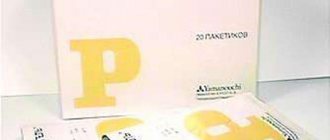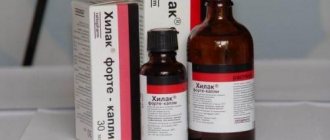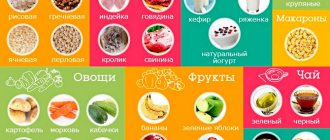Symptoms and causes of infant colic
The period of colic is a restless time not only for the baby, but also for the parents. Signs of the painful condition are not difficult to recognize: crying lasts non-stop for more than three hours every day. Usually at the same time - late in the evening.
The baby screams, pulls his legs to his stomach, clenches his fists, arches his back, strains and blushes.
The cause of pain is most often flatulence. However, it happens that the baby is also worried about other conditions: intestinal dysbiosis, acid reflux from the stomach into the esophagus, as well as increased emotional excitability of the child from bright light or noise.
What to do if your baby spits up
In such situations, you need to look at how the child is developing: whether there is growth retardation, iron deficiency anemia, increased excitability, sleep disturbances. Most often in infants these are anatomical features of the gastrointestinal tract. The sphincter between the esophagus and stomach in an infant is not as pronounced as in an adult and is closed by a different mechanism. This area does not close completely, as in adults, preventing food from returning from the stomach. In young children, this hole is constantly half-open. Thus, when a child lies in a crib and the outlet of the stomach is located higher than the inlet, food is thrown out of it, as if from an open bottle*.
Colic or gas - what's the difference?
In the intestines of a newborn, food is not completely digested. Some of the milk settles on its walls, and fermentation begins. Air bubbles form, the tummy swells and becomes hard. This worries the baby - he grunts, farts often, and can be capricious. Most often this happens during feeding.
The formation of gases does not pose any problem. We must ensure that there is no constipation and that the baby does not overeat. Over time, the digestive system will become stronger. The necessary enzymes will be produced in sufficient quantities, and the problem with gases will go away.
Gas is one of the causes of painful sensations in the tummy - colic. They cannot be confused with anything. The child screams non-stop and cannot be calmed down.
This occurs because a large amount of gases put pressure on the intestinal walls and cause spasms, which are very painful for the child.
Rating of the best mixtures for constipation and colic for newborns
| Nomination | place | Name of product | price |
| The best imported mixtures for constipation and colic for newborns | 1 | Nutrilon (Nutricia) Comfort 1 | 394 ₽ |
| 2 | Friso VOM 1 | 607 ₽ | |
| 3 | Similac Comfort 1 | 557 ₽ | |
| 4 | HIPP Combiotic 1 | 384 ₽ | |
| 5 | Nestle NAN Triple comfort | 600 ₽ | |
| 6 | Nanny 1 with prebiotics | 1 199 ₽ | |
| 7 | Bellakt AR | 209 ₽ | |
| 8 | Humana Anticolic | 556 ₽ | |
| 9 | Mamako 1 Premium | 979 ₽ | |
| The best Russian mixtures for constipation and colic for newborns | 1 | Nutrilak Premium Antireflux | 466 ₽ |
| 2 | Grandmother's Basket AR | 740 ₽ | |
| 3 | Agusha fermented milk adapted No. 1 | 33 ₽ |
Ways to relieve pain
Whatever the cause of pain in a child’s intestines, you always want to alleviate this condition as quickly as possible.
You can help your baby without using medications in the following ways:
- Pat the tummy with a little clockwise pressure
- Provide warmth: Place a warm heating pad or your palm on your baby's belly, or best of all, place your baby tummy down on your belly
- Do gymnastics - press the baby’s knees to the stomach and straighten them several times
- Immediately after feeding, hold the baby upright for 10-15 minutes so that he burps air
- Sometimes motion sickness and “white noise” help babies calm down.
Both breastfed and bottle-fed, not a single child can do without infant intestinal colic, which is sometimes very frightening for young mothers. However, there has never been a baby who did not cry from abdominal pain. They are predisposed by the immaturity of the gastrointestinal tract, which received amniotic fluid in the womb, and then suddenly became acquainted with a completely different product - milk. Moreover, microbes began to colonize the completely sterile intestine, and, unfortunately, not only beneficial bifidobacteria and lactobacilli necessary for the child, but also others. Usually during the first 2 weeks the child sleeps well and is not tormented by colic, but by the end of 2 weeks the calm life of the parents usually ends: the child begins to scream, and some children regurgitate.
In a healthy child, the cry is short-lived, often accompanied by a grimace of pain, pulling the legs towards the stomach. When stroking the tummy clockwise, the pain often goes away. Some children benefit from an upright position, when the mother presses the baby to her chest with her tummy, or by applying a warm diaper to the baby's stomach. A gas outlet tube, invented specifically to facilitate the passage of gas and stool, and completely in vain forgotten and rejected in our days, helps a lot. I am faced with the fact that for some reason they are forbidden to use it, although in 30 years of working with children I have not seen anything but benefits from it. If the crying continues and the above measures are ineffective, you should call a pediatrician.
One of the most common causes of constant colic and regurgitation is an allergic lesion of the gastrointestinal tract. If the baby receives breast milk, the mother should reconsider the diet and not indulge in foods that can cause colic and regurgitation. Let us remind you that these include citrus fruits, chocolate, strawberries, exotic fruits, cow's milk more than 2 glasses per day or condensed milk. If a child already has atopic dermatitis, especially if relatives suffer from allergic diseases, then the list of prohibited foods, unfortunately, expands and this list includes coffee, cocoa, fish, lingonberries, raspberries, black currants, red apples, peaches, apricots, beets .
Blend selection
If breastfeeding is not possible, then how to choose the “right” formula?
If the child is healthy and he and his immediate family have no signs of allergies, any adapted formula is suitable. If the child is healthy, but one of his relatives (parents, brothers, sisters, grandparents) has allergic diseases, the preferred preventive hypoallergenic (HA) mixtures, for example, NAN GA 1 or 2, Nutrilon GA 1 or 2, depending from age and other mixtures.
However, there are a number of diseases for which the administration of hypoallergenic mixtures is ineffective, and in this case it is necessary to use mixtures that either do not contain cow's milk protein replaced by soy protein (NAS soy, Frisosoy, Nutrisoya) or goat's milk proteins (Nanny, Nanny Golden Goat) , or mixtures with fully hydrolyzed cow's milk protein. Feeding with soy formula ensures normal growth and development of infants, but in recent years there has been evidence of an increase in the number of children with allergies to soy proteins.
If mixtures based on soy protein or mixtures based on goat milk can be prescribed by a family doctor, then the so-called “hydrolysates” should be prescribed by a specialist - an allergist or gastroenterologist, since they require certain rules of administration, the main one of which is gradualism. Hydrolysates include such mixtures as Alfare, Pepti TSC, Nutramigen, etc. They do not have a very pleasant taste, but if a child is switched to this mixture and receives it for a long time, then he gets used to its taste. In addition, a child’s taste sensations are very different from yours and mine, and under no circumstances should you be equal to yourself. In the Alfare mixture, whey protein, rich in cystine, which is involved in the antioxidant defense of the body, undergoes hydrolysis. Whey proteins have high anti-inflammatory activity, which is necessary for allergic damage to the mucous membrane of the small intestine. The fatty component is represented by fatty acids that do not require re-cleavage, which greatly facilitates their absorption.
If we ignore allergic diseases of the gastrointestinal tract and consider separately the diet for regurgitation (we have already discussed in detail the topic of vomiting and regurgitation), then the first principle of diet therapy is the organization of fractional nutrition: increasing the frequency of feedings with a decrease in one-time volume. In addition, after feeding, the child should be kept in an upright position for some time (up to 10 minutes) to ensure the unhindered release of swallowed air.
The next direction of diet therapy is the selection of antireflux mixtures (that is, mixtures that prevent regurgitation). The effect of the mixture is based both on the content of various constituent proteins (the more casein, the thicker the lump of curdled milk), and on the properties of various thickeners, for example, rice, corn starch or gum, that is, carob gluten. The swelling of gum, which is a dietary fiber, increases the viscosity of the milk formula. Gum, unlike starches, is not digested, which is a great advantage, and reaches the large intestine unchanged, where it serves as a food substrate for bifidobacteria. Mixtures containing gum are indicated if a child is prone to constipation, as the gum gently stimulates the intestines and softens the stool. On the contrary, mixtures containing rice starch as a thickener are indicated for children with a tendency to loose stool.
When using mixtures containing thickeners, preparation instructions must be strictly followed. In addition, you should give your child extra water - about 200 ml per day - since gluten retains water in the intestines, preventing it from being absorbed.
An example of an antireflux mixture, the creation of which took into account all approaches to the dietary correction of regurgitation syndrome, is Nutrilon Antireflux (“Nutrition”). The mixture is distinguished by a moderate (0.4% per 100 g of mixture) concentration of gum as a thickener, has a casein dominant protein component with a whey to casein ratio of 20/80 and a moderately reduced fat content. The Frisovom mixture (“Friesland Foods”) contains only a thickener - 0.6% gum per 100 g of the mixture, while the casein content is not increased and the fat content is also not changed. The mixture Samper Lemolak (“Samper”, Sweden) contains rice starch as a thickener with a protein ratio of 60/40 in favor of albumin and normal fat content. Nutrilak antireflux (AR) and Enfamil AR mixtures are also well tolerated.
Before transferring a child to an antireflux formula, a consultation with a pediatrician is necessary. The transition to the mixture is carried out in compliance with the rules for introducing a new product - gradual replacement of the old mixture with a new one. It is also possible to displace the mixture (starting with 5-10 ml at the beginning of feeding), reaching the full volume within a week. According to in-depth research and our observations, the effect of using the mixtures occurs within 10-14 days. The mixtures can be used for a long time. Most of the antireflux mixtures can be used from birth (Frisov 1, Humana AR, Lemolak, etc.).
Concluding the conversation about regurgitation and its dietary correction, I would like to emphasize once again that if regurgitation is persistent, profuse, frequent, affects the child’s condition and its development and does not go away with dietary correction, a mandatory examination is necessary to identify the causes.
How to prevent colic. Prevention
Different methods of prevention help different children. Listen to yourself, try different options and you will definitely find the one that suits you.
- Place baby on tummy before feeding
- Gently massage your tummy in a clockwise circular motion.
- Bathe your baby in a bath with soothing herbs – mint, motherwort
- Use anti-colic nipples for feeding. They reduce the amount of air swallowed
- If your baby is bottle-fed, choose formulas with probiotics - beneficial bacteria that help digestion
- Eliminate gas-inducing foods from your mother’s diet.
- If the baby is breastfed, pay attention to the correct attachment to the breast and the amount of air captured
The best Russian mixtures for constipation and colic for newborns
Russian baby food manufacturers are also of the opinion that breast milk is preferable for young children. But breastfeeding is not possible in all cases, so they produce high-quality baby food that helps newborns with digestive problems.
Nutrilak Premium Antireflux
Rating: 4.9
Dry milk formula Nutrilak Premium Antireflux contains natural carob gum, which regulates the functioning of the gastrointestinal tract, restores intestinal microflora, and promotes regular bowel movements. This product also contains natural milk fats, Omega-3 fatty acids, and nucleotides. The mixture is free of palm and rapeseed oil.
Nutrilak Premium Antireflux is sold in cardboard boxes of 350 g. The mixture is similar in consistency to milk powder with a creamy tint. It mixes very well without forming lumps, but it turns out quite thick, so you need to choose the right nipple for the bottle. Children like its taste and eat it willingly. After opening the package, the dry mixture is stored for no longer than 3 weeks.
According to reviews, Nutrilak Premium Antireflux is great for constipation, colic and frequent regurgitation. After the first day of use, the newborn’s stool improves, he is less capricious due to colic, and his general well-being improves. But not all parents can agree with this, since some children develop diathesis with prolonged use of Nutrilak Premium Antireflux.
Advantages
- carob gum in the composition;
- pleasant to the taste;
- children like it;
- It relieves constipation and colic well.
Flaws
- in some it causes diathesis.
Grandmother's Basket AR
Rating: 4.8
Dry milk formula Babushkino Lukoshko Antireflux BIO contains natural dietary fiber (locust bean gum), which normalizes intestinal activity, relieving the baby from constipation. The carefully selected level of protein does not put extra strain on the kidneys and meets all the child’s needs. The composition also contains polyunsaturated fatty acids, nucleotides and selenium.
Grandmother's Basket Antireflux BIO is available in 400 g cans. It looks like standard dry baby food. Has a pleasant smell. The mixture dissolves without problems. The result is thick milk without lumps. This mixture is not given on an ongoing basis, but is used as a necessary measure. Newborns readily consume it, but you need to put the right nipple on the bottle to make it easier for the baby to get food.
Reviews about the Babushkino Lukoshko AR mixture are mostly good. But parents complain that it is not always easy to find on sale. Almost no one has any complaints about the effectiveness of this baby food. After only 1-3 days of using this mixture, newborns experience constipation - they absolutely calmly empty their intestines up to 3 times a day. Parents also note that babies’ colic goes away almost completely.
Advantages
- carefully selected and balanced composition;
- easy to divorce;
- pleasant taste;
- quickly normalizes digestion.
Flaws
- not always easy to find on sale.
Agusha fermented milk adapted No. 1
Rating: 4.7
Liquid formula Agusha adapted fermented milk No. 1 is recommended for feeding infants from birth to 6 months with artificial and mixed feeding. It is created on the basis of partially hydrolyzed proteins, enriched with probiotic cultures, L-carnitine and nucleotides. The product does not contain preservatives.
Agusha adapted fermented milk is sold in tetrapacks of 200 ml. There is no need to dilute it - it is already ready for use. She has a shelf life of 14 days. It needs to be stored in the refrigerator, so it needs to be warmed up before feeding the baby. The taste of the mixture is not particularly pleasant - it is sour.
In reviews of the Agusha liquid formula, parents note that not all newborns are willing to use it. But the effect of it develops within 2-3 hours. If before this the baby was constipated, then after Agushi he freely empties his intestines without crying. By consuming such a liquid mixture, babies also experience less colic and spit up less. This product does not cause any allergic rashes.
Advantages
- effective "kefir"
- quickly eliminates constipation;
- relieves colic and frequent regurgitation;
- does not cause allergic reactions.
Flaws
- palm oil included.
Preparations with probiotics
Linex is a popular drug with probiotics.
Probiotics are beneficial microorganisms similar to those found in the intestines of healthy adults.
In the right doses, such bacteria can help normalize digestion. Popular preparations with probiotics:
- Bifiform;
- Bifidumbacterin;
- Linux;
- Acepol;
- Hilak Forte.
- Preparations based on "simethicone"
It is believed that the active substance "simethicone" is safe for infants, since it is not absorbed in the intestines and is not addictive. That is why it is actively used to relieve pain from colic and reduce gas in infants. Frequently prescribed drugs containing “simethicone”:
- Espumisan (emulsion or capsules);
- Subsimplex;
- Bobotik.
For more information about what to give a newborn for colic, watch the video:
Diseases in children in which regurgitation is frequent
There are a number of diseases in which regurgitation is a pathological, dangerous symptom. First of all, these are diseases such as pyloric stenosis and pylorospasm. In the place separating the stomach and duodenum, there is a sphincter, as at the entrance to the esophagus. When the food is sufficiently prepared in the stomach, it opens, pushing it into the duodenum. With pylorospasm, a spasm of this sphincter occurs, and food is not completely removed from the stomach. With pyloric stenosis, food is not excreted almost completely. In both cases, when feeding the baby, the stomach becomes full, since it has not yet gotten rid of the remnants of the previous feeding, and the baby begins to spit up. In these cases, regurgitation is profuse, often has a cheesy consistency and a sour smell. Typically, these diseases appear around 2–4 weeks of a child’s life. If pyloric spasm can be overcome by taking antispasmodic drugs, then in case of pyloric stenosis, surgical treatment is necessary. In any case, consultation with a surgeon is necessary to confirm the diagnosis and treatment.
What is colic?
In pediatrics, colic refers to periodic abdominal pain that occurs for two interrelated reasons: spasm of intestinal smooth muscles and excessive gas formation. Colic is considered a physiological norm; it appears at about 2-3 weeks of a child’s life and disappears without a trace by 4 months.
They can be diagnosed by the following behavioral characteristics of the baby:
- crying and worry . They usually appear in the evening, 20-30 minutes after the next feeding;
- characteristic changes in a baby's facial expressions before a cry . The child winces, groans, twists his mouth;
- The child either calms down for a few minutes, then starts screaming again . This is due to the fact that abdominal pain is wave-like;
- reluctance to take the breast or refusal after several sucking movements;
- tense, hard stomach;
- characteristic pose : arms with clenched fists pressed to the body, the back is arched, the legs move restlessly, the face turns red.
Visible relief occurs immediately after defecation and passing of gas: the baby calms down and remains calm until the next attack, eats well, and gains weight normally. The attacks recur approximately three times a week and last about 3 hours.
To rule out other possible causes of restless behavior, you can:
- measure the temperature (with colic it remains normal);
- examine the child’s skin (they must be clean);
- make sure that the child is fed, and that his clothes do not rub the body anywhere or gather in rough folds.
Preparations based on natural herbs
BabyCalm is good for colic.
Modern pharmaceutical preparations based on natural herbs are essentially nothing more than folk remedies that were well known to our great-grandmothers, just in a more convenient “packaging” with a precisely calculated dosage.
So, infusions containing fennel, cumin, chamomile and dill seeds are good for stomach colic. And on pharmacy counters such products can be found under the following names:
- BabyCalm;
- Bebinos;
- Plantex.
Note to young parents: pediatricians usually prescribe infants a number of drugs to relieve colic at the same time, offering to try each of the drugs in turn. However, it should be remembered that any drug intervention in the natural process of gradual formation of microflora in the baby’s intestines can subsequently negatively affect the child’s health.
Sometimes it makes sense to just wait until the child is three months old. As a rule, by this time colic in infants stops on its own.
Anti-colic medications prescribed for newborns
Anti-colic medications for newborns are produced primarily in liquid form.
Medicines for newborns are available in both liquid form and capsules. The latter should under no circumstances be given to the baby in their “pristine” form.
The capsule should be broken, and the powder that spills out should be diluted with water or breast milk. Typically, to relieve colic in newborns, pediatricians prescribe drugs from one of the following groups:
- containing probiotics;
- based on a special active ingredient “simethicone”;
- rich in digestive enzymes;
- based on natural herbs.
Let us consider the advantages and disadvantages of each of the listed types in more detail.










